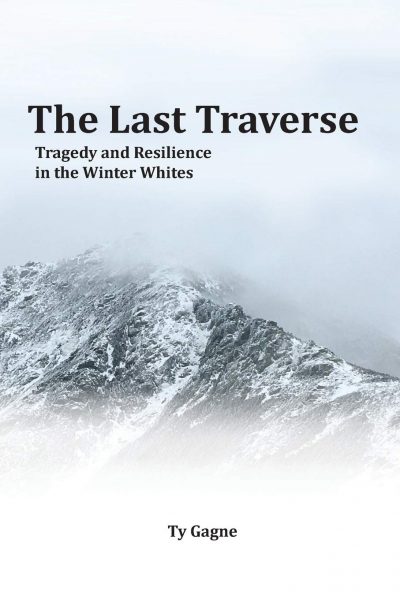 Any lover of White Mountain stories should pick up a copy of Ty Gagne’s (author of Where You’ll Find Me) book, The Last Traverse: Tragedy and Resilience in the Winter Whites, which details the harrowing and tragic hiking trip two friends took on one of New Hampshire’s most iconic hikes, Franconia Ridge. A cautionary tale about venturing above treeline in the Whites in the winter (and an absolute page-turner), this book is a must-read for anybody who frequents this terrain during the Northeast’s colder months.
Any lover of White Mountain stories should pick up a copy of Ty Gagne’s (author of Where You’ll Find Me) book, The Last Traverse: Tragedy and Resilience in the Winter Whites, which details the harrowing and tragic hiking trip two friends took on one of New Hampshire’s most iconic hikes, Franconia Ridge. A cautionary tale about venturing above treeline in the Whites in the winter (and an absolute page-turner), this book is a must-read for anybody who frequents this terrain during the Northeast’s colder months.
An Epic Pageturner
The Last Traverse provides a multi-person view of a White Mountain epic. The central characters are two hikers stuck between a big February day in the mountains and an all-out overnight fight for survival above treeline on Franconia Ridge. As the duo’s situation becomes more dire, the book picks up in intensity, getting harder and harder to put down. Using hourly weather reports from the Mount Washington Observatory to help set the scene, Gagne both keeps the book on a timeline and paints a vivid picture of the serious situation the hikers got themselves into.
Around the survival story, Gagne layers multiple locations, viewpoints, and personalities. For example, while the two hikers are battling full-winter conditions above treeline, Gagne introduces others on the trail that day, including the search and rescue teams racing up the mountain and the New Hampshire Air National Guard rescue chopper’s crew pushing their (and their helicopter’s) limits in the extreme weather. The reader also gets the perspective of the medical staff at Littleton Regional Hospital dealing with the aftermath. Seeing the story unfold from a variety of angles makes The Last Traverse surprisingly rich.
The Last Traverse also serves as a cautionary tale about the importance of making good decisions in the mountains. It’s here Gagne does a great job of highlighting the factors that contributed to the situation, without judgment or criticism.

Learning from Disaster
Gagne doesn’t overtly point out any particular lessons in The Last Traverse, however, astute readers will find plenty to take away from this book. A noticeable overarching message is that small decisions can have huge consequences in the mountains, especially in winter. And an important related takeaway is the importance of conservative decision-making on days when there’s a possibility that the weather above treeline will be bad.
Another inference avid hikers can make is the importance of being prepared to spend an unplanned night out. While the hikers in The Last Traverse climbed themselves into trouble, the fact is everyone is just a broken leg or some other unfortunate turn of events away from a night in the mountains. Here are some items you should consider adding to your winter hiking pack, just in case:
- Sleeping bag: In The Last Traverse, Gagne writes about how one of the hikers considered bringing a sleeping bag but left it behind, opting for a lighter pack and moving faster with less of a safety net. One can only imagine how differently the story may have ended if he chose to pack the bag. Even one sleeping bag carried amongst a hiking team can add a margin of safety if one group member is injured.
- Puffies: An alternative to a sleeping bag is insulated outerwear—an extra puffy coat and puffy pants are like an insulated action suit or a sleeping bag you can wear and walk in.
- Sleeping pad: Gagne writes about how the ground sapped the warmth from the pinned-down hikers. A closed-cell foam sleeping pad is a lightweight and inexpensive addition to any winter hiking kit. Even in non-emergency situations, it can provide a warm place to sit in winter.
- Bivy sack: These minimalist shelters protect you—and your sleeping bag—from wind and moisture. While the hikers in The Last Traverse did have space blankets, a bivy sack provides more protection and security. (Spoiler alert: one of the hikers loses a space blanket to the wind).
- Stove: Hiking in the winter burns a lot of calories and a great way to get warm is from the inside out. Stoves are small, lightweight, and can deliver much-needed calories and warmth in winter.
- Hand warmers: While no substitute for heavy-duty mittens or puffy coat pockets, hand warmers are perfect for keeping your digits toasty. If you get stuck spending a night in the mountains, you can even toss a few at the bottom of your sleeping bag to keep your toes warm. Throw a few pairs in your first-aid kit, you won’t regret it.
Armchair Mountaineers
Anyone who has spent time in the Whites during winter will find themselves transported by The Last Traverse to above treeline on Franconia Ridge, feel the wind working its way through their layers, and sense the granite, ice, and snow crunching under their spikes. They will also likely feel thankful they’re reading in the comfort of their home and not battling for their life in blizzard conditions. However, if they do end up in their own epic, hopefully they will have taken some of the lessons of this book to better prepare themselves.
Tim Peck and Doug Martland
Tim and Doug met long ago at the Eastern Mountain Sports in Canton, Massachusetts. Bonding over a love of slick Quincy Quarry granite, White Mountain sufferfests, and scheming up adventures while folding tee-shirts, today Tim and Doug collaborate to write about their favorite outdoor activities and occasionally get nostalgic about tee-shirt tables.




